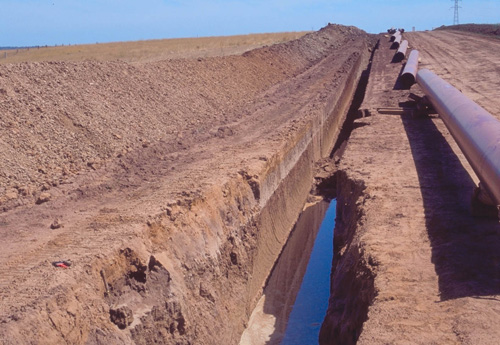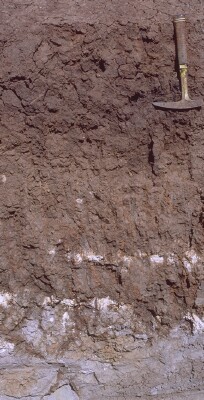SW97
Location: Batesford
Australian Soil Classification: Vertic (& Sodic), Calcic, Black DERMOSOL (deep profile depth)
General Landscape Description: Undulating rises.
Site Description: Simple slope on side of open depression.
Geology: Quaternary Basalt - Newer Volcanics
 SW97 Landscape |
Soil Profile Morphology:
Surface Soil
| Ap | 0-15/20 cm | Very dark brown (10YR3/2); fine sandy clay loam; pH 6.0: |  SW97 Profile - Note: Surface stripped from soil profile. |
| Subsoil | |||
| B21t | 15/20-40/50 cm | Black (7.5YR2.5/1 moist) with dark red (10R3/6 moist) mottles; light clay; very coarse roughly prismatic, parting to very coarse angular blocky structure; slickensides present; pH 5.2: | |
| B22gt | 40/50-110 cm | Strong brown (7.5YR5/8 moist), dark greyish brown (10YR4/2 moist) and grey (7.5Y5/1 moist) vertically mottled; light clay; slickensides prominent; band of soft carbonate at 90cm depth in mottled clay matrix; pH 9.4: | |
| B23k | 110-130 cm | Band of soft carbonate in mottled clay matrix; pH 9.6; clear change to: | |
| C | 130+ cm | Grey (5Y5/1 moist); soft vesicular weathered basalt. |
Key Profile Features:
- Gradual increase in texture between surface (A) horizon and subsoil (B2) horizon.
- Calcium carbonate in deeper subsoil.
- Vertic features (i.e. slickensides in deeper subsoil)
Soil Profile Characteristics:
pH | Salinity Rating | |||
Surface (A1 horizon) | Moderately Acid | Low | Non-Sodic | None1 |
Subsoil (B21 horizon) | Moderately Alkaline | Low | Strongly Sodic | Strong |
Deeper subsoil (at 70+ cm) | Extremely Alkaline | Medium | Strongly Sodic | None2 |
| 1 Moderate - strong dispersion after remoulding. 2 No aggregate dispersion probably due to high level of soluble salts, strong dispersion after remolding. | ||||
 |
| The surface is moderately acid. The subsoil is moderately alkaline becoming extremely alkaline at depth. | Salinity rating is low in the surface and upper subsoil and medium in the subsoil. | The soil is non sodic in the surface and strongly sodic in the subsoil. | The clay content is moderate throughout the profile. |
Horizon | Sample Depth (cm) | pH (water) | pH (CaCl2) | EC 1:5 | NaCl % | Exchangeable Cations | |||
Ca | Mg | K | Na | ||||||
meq/100g | |||||||||
Ap | 0-10 | 6 | 5.2 | 0.16 | 6.5 | 5.8 | 0.91 | 1 | |
B21t | 20-40 | 8.2 | 7 | 0.24 | 6.6 | 9.8 | 0.74 | 4.1 | |
B22gk | 60-80 | 9.4 | 8.4 | 0.58 | 0.03 | 7.7 | 11 | 0.8 | 7.5 |
B23k | 90-110 | 9.6 | 8.7 | 0.65 | 0.04 | 8.9 | 13 | 0.5 | 9.3 |
Horizon | Sample Depth (cm) | Exchangeable Aluminium mg/kg | Exchangeable Acidity meq/100g | Organic Carbon % | Nitrogen % | Field Capacity pF2.5 | Wilting Point pF4.2 | Coarse Sand (0.2- 2.0 mm) | Fine Sand (0.02- 0.2 mm) | Silt (0.002- 0.02 mm) | Clay (<0.002 mm) |
Ap | 0-10 | <10 | 10 | 2.7 | 0.25 | 24.9 | 13 | 18.6 | 36.9 | 9.5 | 29 |
B21t | 20-40 | 40.3 | 19.3 | 17.3 | 31.2 | 8.5 | 38 | ||||
B22gk | 60-80 | 44.6 | 21.3 | 14.9 | 26.2 | 20 | 34.5 | ||||
B23k | 90-110 | 45.7 | 21.2 | 16.2 | 27.4 | 13.5 | 38.5 |
Management Considerations:
Subsoil (B) Horizons
- The subsoil displays vertic features (i.e. slickensides) which indicates that significant shrinking and GPelling occurs during wetting and drying cycles. This may have engineering implications and is likely to explain the variability in surface horizon depth across the trench.
- The dense and coarsely structured subsoil is strongly sodic and disperses strongly in water. This will result in restricted root and water movement into the subsoil.
Profile Described By: Richard McEwan (February 1999).


